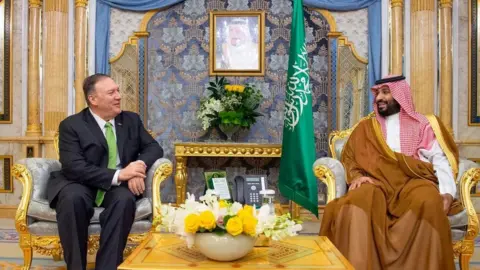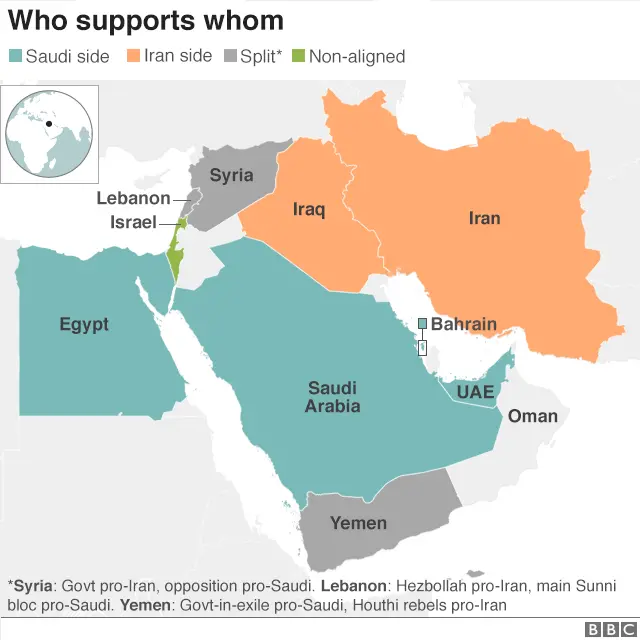Saudi Arabia oil attacks: Trump blames Iran but what are his options?

As he struggles to define a response to the attacks against key elements of Saudi Arabia's oil infrastructure, President Donald Trump has insisted that he has many options.
He has already chosen to employ one of them, ordering stepped up economic sanctions against Tehran - which denies carrying out the attack - and doubling down on the policy of "maximum pressure" against Iran which the US insists is having a significant impact.
The problem is that many critics of the administration believe that it is this very policy, President Trump's decision to abandon the international nuclear agreement with Iran and step up economic pressure, that has brought us to this current point. So what can the Americans do? What really are the options? Is this really America's business? And if so, what is the likelihood of some kind of military response to an attack which the Americans clearly believe came from Iran?
First it is important to realise that any action can be immediate or it can play out over time. It can be overt, in the full glare of publicity, or it can be covert, hidden from public view. First though, the US and the Saudis need to make the public case; to establish clearly what happened and to provide corroborating evidence that places responsibility firmly with Tehran. This will provide the public and legal case for any response and it will help to garner wider international support for any steps taken.
This was, after all, according to US Secretary of State Mike Pompeo, "an act of war". Despite all the Iranian denials the information released so far shows Iran to be deeply implicated in these attacks. But much more detail is needed, not least an answer to the crucial question: was this attack, as some US officials say, actually launched from Iranian soil? Once the case has been made, what then can President Trump do?
Economic pressure
While there are no details as yet, the president's initial response has been to call for more economic sanctions. There is no doubt that the Iranian economy is hurting. That, many analysts say, is why Iran may have decided to strike at Saudi Arabia's oil infrastructure now. It is a warning that Washington's economic war against Tehran can be met by an Iranian response against Riyadh. The attacks have demonstrated Saudi Arabia's extraordinary vulnerability, a factor that has to be central when considering any military riposte.
The other problem with simply stepping up the "maximum pressure" campaign is that there is not much left for the US to do. The economic pressure gauge is pretty much already at maximum. Over time the impact of this campaign on Iran will get worse. But despite US claims that it is working, few analysts see any sign of Iran moderating its wider behaviour in the region. If anything, pressure is building and Iran's allies and proxies like Hezbollah or pro-Iranian militias in Iraq are only getting stronger.
A military response
There was a time when an attack against oil supplies in the Gulf would have been a clear red line for the Americans, prompting a massive and predictable show of force. Oil fundamentally is what gives this region its strategic importance.
But things are changing. The US now gets a growing proportion of its oil from its own supplies. It is hard to say if President Trump, for all his rhetoric and flattery of the Saudi royals, really sees these recent attacks as compromising a profound US national interest. He is clearly a president who wants to end US military adventures abroad and not start new ones. And for a variety of reasons, Saudi Arabia is losing more friends than it is winning on Capitol Hill.
But suppose the US decides that its vital interests are at stake, what then? The military options and potential target lists vary. The real question is: what is the use of force intended to achieve? It could for example be a token strike - like the attack Mr Trump ordered against a Syrian chemical weapons base, which did little to deter the Assad regime and its further use of chemical weapons drew no additional US response.
 Reuters
ReutersAlternatively if a real military effect is intended, then any strike would have to be carefully calibrated - proportional in the sense that it matched the scale of the severity of the attack against Saudi Arabia, but also strong enough to send a clear message of deterrence.
The risk of escalation
One man's deterrence though is another man's provocation. Iran shows no signs of being cowed. And there is a real risk that tensions between Iran and the US could descend into outright conflict. So where might such a conflict go and what would it look like?
There are many variables to consider and it is easier to say what will not happen. The Trump administration may be an implacable foe of the Iranian regime but there is not going to be a full-scale ground invasion of Iran to topple it. This is not Saddam Hussein's Iraq. Iran is an altogether more complex challenge, both militarily and politically. Some in the White House clearly want regime change. They are likely to be disappointed. So rule out a major land war.
The US can deliver punishing strikes against Iran's military infrastructure. But Iran has the means to strike back too. It can use a variety of measures from mines, swarming small boat attacks or submarines to disrupt operations in the confined waters of the Gulf. Oil tankers could be attacked, forcing the Americans to take steps to protect them too.
Where the US clearly has an extraordinary advantage is in intelligence-gathering and situational awareness. But as the downing of a highly sophisticated American drone in June shows, there are significant US vulnerabilities too. Operating modern warships in the confined waters of the Gulf presents a variety of challenges. All Iran may think it needs to do is to damage or sink a few US vessels to make the price of this conflict one that Mr Trump will not want to pay.
Iran, if under sufficient pressure, might also seek to spread the conflict more broadly, urging its proxies in Iraq, Syria or elsewhere to attack US targets. In extremis it might even try to prevail upon Hezbollah (in concert with its own forces in Syria) to launch rocket attacks on Israel. The goal would be to demonstrate to Washington that what Mr Trump might see as a short punitive campaign actually risks setting the region on fire.


Covert options
These range from stepped up cyber-attacks to clandestine efforts to sabotage Iranian military programmes and undermine its allies and proxies across the Middle East. But again, many of these activities have been under way for some time and we are now where we are. Iran has not been deterred, though its technical progress has almost certainly been affected.
Diplomatic responses
This may not appear to be President Trump's "go-to" solution, but there could be some benefits in seeking to "internationalise" this crisis. This would require as detailed a presentation of the facts as possible, a kind of "name and shame" effort against Iran to try to increase its isolation.
The difficulty here is that even the US and its key Western allies remain divided on exactly how to tackle Tehran, even if they have a broadly similar assessment of the "Iranian problem". The Europeans still hope against hope that the nuclear deal with Tehran can be preserved. Many other countries, not least Russia and China, while having no illusions about Iran, tend to see this as just a "Trump problem" and are unlikely to rally to a campaign of diplomatic maximum pressure.
Of course there is another diplomatic approach that could be pursued to de-escalate things: they could try talking. Before this episode, there were various suggestions that President Trump might be open to some kind of meeting with the Iranians. That may now be even more unlikely, and it is hard to see what any Iranian leader would stand to gain domestically from such talks.
